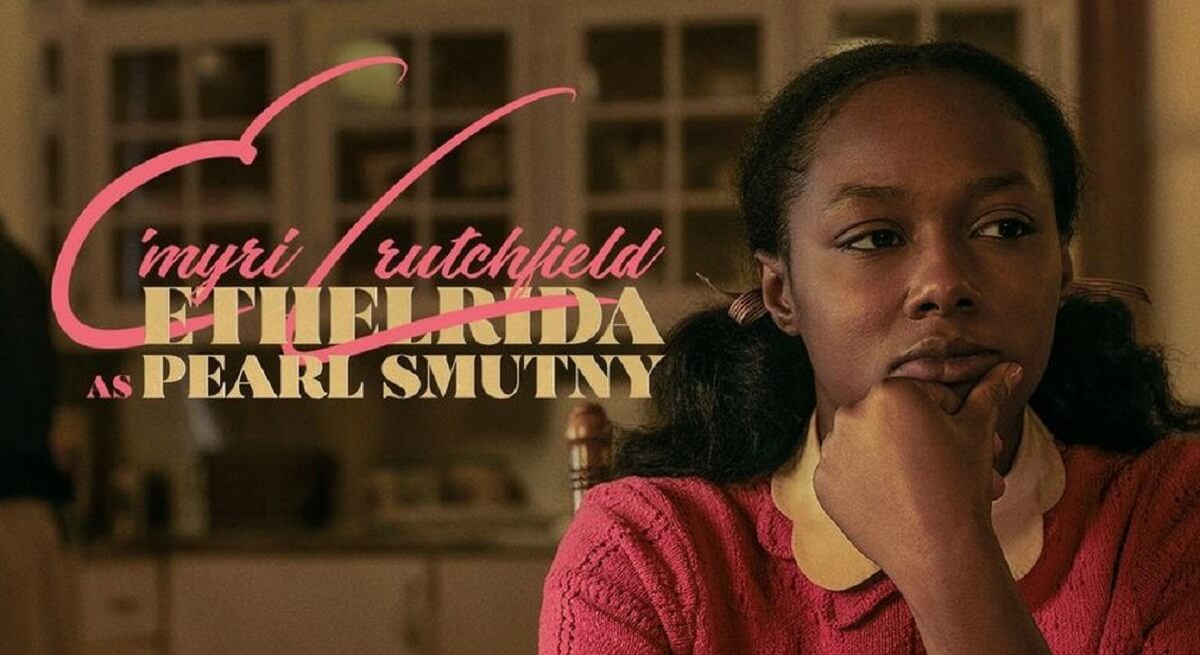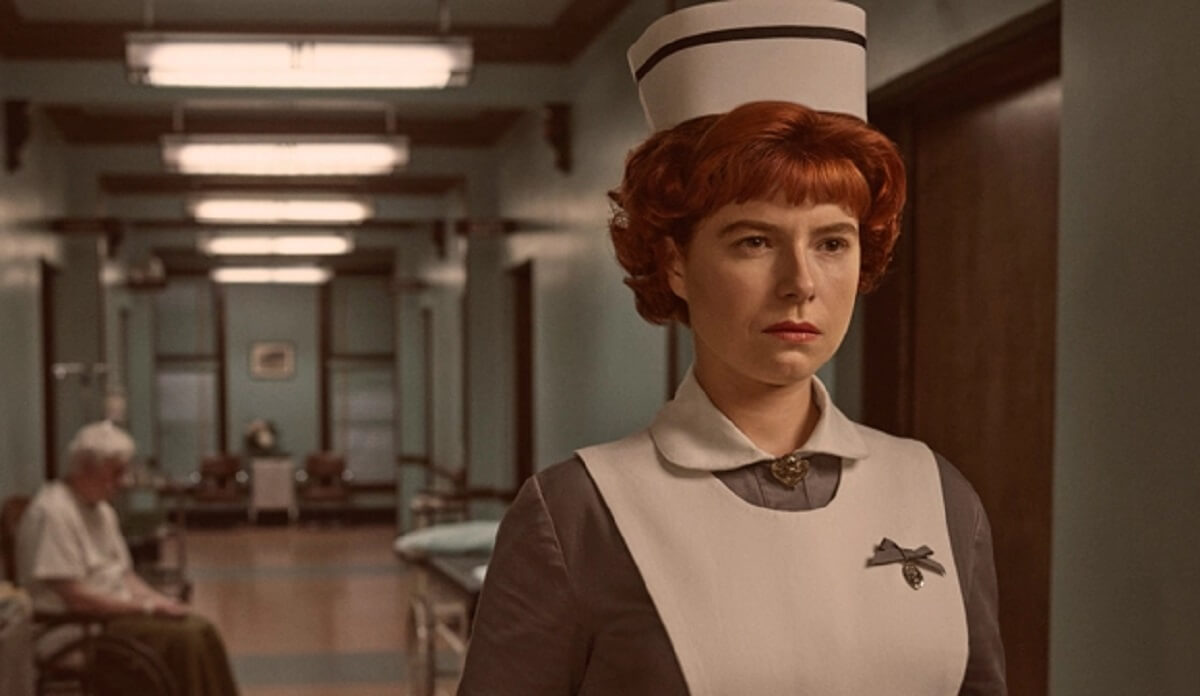
Truth, Lies and Race: “Fargo” and the Pop Culture Dream of America

The new season of Fargo begins with a sixteen-year-old Black girl, Ethelrida Pearl Smutny, a straight-A student, pushed into the foyer of her principal’s office. Within the principal paddles an unseen student.
“My history report, by Ethelrida Pearl Smutny,” we hear her say in voice-over as she waits. “Frederick Douglass once intoned, ‘I stand before you as a thief and a robber. I stole this head, these limbs, this body from my master and I ran off with them.’”
“My point being,” she goes on, as the camera pulls back to reveal that the student being paddled by the white male principal is a young black man, “the moment our feet touched American soil we were already criminals.”
The principal finishes and extends his hand until the boy finally shakes it. Then he comes out for her, face flushed. “Next.”
Based loosely on the film of the same name, FX’s anthology series Fargo tells season-long stories of ordinary people who make one small choice either to cheat the system or to be brave and find themselves soon caught up into ever-escalating scenarios of danger, violence, and existential questions of fate and free will. It’s Kafka meets the Coen Brothers, with the broad nasal melodies of the land of a thousand lakes usually figuring prominently.
The current season has diverged dramatically from some of those parameters. We’re in Kansas City, not Minnesota. It’s 1950, and the story revolves around not ordinary people but two competing crime families, the Italian Faddas and the black Cannons, who have traded their youngest sons to each other in an attempt to keep the peace. (Fargo loves a good biblical allusion, and this season is filled with them.) While Ethelrida and her family seem to stand as this season’s version of the “normal people who get sucked in,” mostly Ethelrida herself stands above the fray, watching the events and seeing in them the story of America.
American pop culture and political philosophy have three things in common: First, they tell stories that present certain idealistic truths as representative of the character of our country. All men are created equal. America is the land of the free and the home of the brave. “I’m here to fight for truth and justice and the American way,” gushes Christopher Reeve’s Superman.
Second, they are lying. The stories of pop culture and American political philosophy are often con jobs, indoctrination meant to make us believe certain things about our country and resist others, even as the lies being told are frequently as obvious as lipstick on a collar. As any grade school child will tell you, many of the men who signed on to “all men are created equal” held enslaved people, and all of them only owned property as a result of the prior displacement and mass murder of Native populations. This itself usually was justified with the argument that Native men weren’t civilized and therefore not fully men or not men at all.
This statement of equality in the Declaration of Independence, which lies at the very foundation of our country’s ideals, offers nothing to the gender responsible for the writers’ existence in the first place.
It’s not a matter of chance that there are so few women, people of color, or queer characters among the superhero pantheons of Marvel Studios or DC/Warner Brothers, or that years go by where almost no actors of color are nominated for major film and television awards, or that so many pop culture presentations of women from even just ten years ago are filled with sexism and violence. White supremacy and misogyny are not glitches in our nation’s operating system. They are key features.
We know this, and yet we continue to let ourselves be swept off our feet by sweet-sounding ideals of liberty and justice for all, sung by men who still have dirt packed under their fingernails from the ground where they buried the bodies of America’s many victims.
While Fargo has not considered these questions in any depth before, for its entire run it has been interested in the relationship between truth and fiction. Every episode – and the Coen Brothers movie that preceded the series – begins the same way: “This is a true story.” And yet the series is fiction. Its every moment is complete fabrication. The series is constantly trying to make its audience aware of the truth about stories, how they promise us a mirror and then provide only interpretation with some features accentuated and others airbrushed out.
At the same time, for Fargo creator Noah Hawley stories have their own truth. His take resembles that of Scripture: the events of Genesis didn’t really happen, and yet they are also absolutely true in their characterization of who God is, who we are, and what life is about. And this is the third thing that pop culture and American political narrative have in common: even as they scatter fictions about like some malevolent asbestos-laden fairy dust, within them also lies the possibility of great revelation.
HBO’s Watchmen, a superhero story, began by telling the actual history of the 1921 massacre of Black residents of Tulsa by the city’s white population. Lovecraft Country placed Black people and women at the center of a series of familiar science fiction, fantasy and horror tropes – the haunted house, the temple dig, the cursed pirate ship — and revealed both the racism and misogyny of our conventions and the fresh stories possible with diverse cast members.
Our civil rights movements have likewise drawn on the principles formulated by the white men who wrote our founding documents in their fights for justice. Our country might not have in fact been created by the people, of the people or for the people, but that doesn’t mean there isn’t material there those who were forgotten or victimized can’t use.
Halfway through its new season, Fargo attempts its own excavation of American history and culture. As the opening scene with Ethelrida suggests, it is interested in questions of race and the threat of institutionalized violence and murder that looms over Black Americans’ entire existence.
The thematic line of the series seems to be the destabilization of many of our typical American categories. Although they stand on opposite sides, the Italian and Black mobsters experience similar treatment by the broader American society. “None of ‘em were white,” Ethelrida says of the series of gangs that ruled early twentieth-century Kansas City. “They were Dagos, Negroes, Micks, all fighting for the right to have been created equal.”
“But equal to what? And who gets to decide?”
Neither group is monolithic within itself either. The Italian mob is riven with division: one son, raised in America, buys into the system the gangs have created to do business and keep the peace; the other, raised in Italy, wants only to murder and to take. Meanwhile, the Cannon gang gets robbed by a Black woman and her Native partner, and it has no reservations about threatening to kill Ethelrida and her Black mother.
Fargo also repeatedly undermines the equation of whiteness with “good American.” U.S. Marshal Dick “Deafy” Wickware seems to embody the very definition of the Western cowboy (right down to being played by Deadwood and Justified great Timothy Olyphant). But he belongs to the Church of the Latter Day Saints, a group whose religious practices have left it distrusted outsiders in much of American society.
Minnesota native Nurse Oraetta Mayflower’s accent, pie-making skill, and discomfort with filthy language likewise make her seem to be the very embodiment of a Midwestern Americana. But she secretly has poisoned and killed hundreds of her patients and others for fun.

With each episode, the groups and conflicts of Fargo become less coherent, with more and more forces brought into play (including the Angel of Death itself) working to their own purposes. While characters are constantly talking about America (which is such an American pop culture thing to do), their stories about it contradict each other and sometimes even themselves.
The more we hear and witness, the more America appears as a chaos of individuals flying in every direction, like subatomic particles just smashed into existence in a super-collider.
Is that atomization of American conflicts a revelation or a dodge? Does it suggest a fresh path forward, or is it just another strategy to hide the brutal truths of our nation, akin to saying white supremacists and those who oppose them just have a difference of opinion?
Can it be both? Is that not what makes a thing “true”, an insistence on clinging to the contradictions and seeing where they take us, rather than ignoring or dispelling them?
If there is hope to be found in this whirlwind that is Fargo’s America – and maybe our own — it would seem to be in our teenage narrator, who confronts clear-eyed the truth of American history and tries to navigate its frightening, ever more violent landscape, wondering at the dream.

